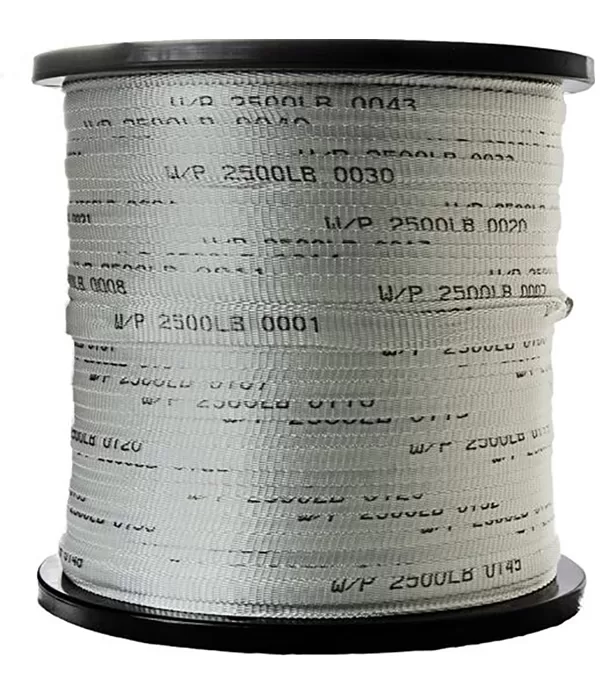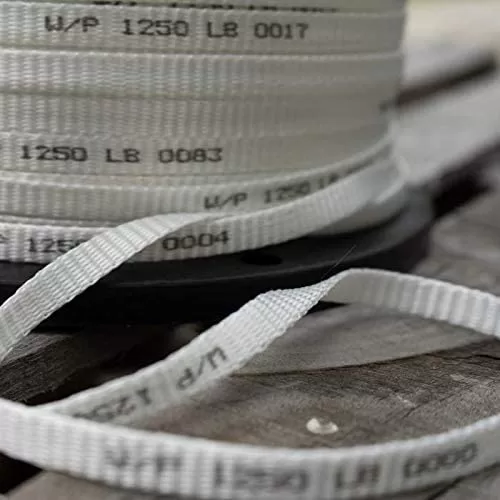Cinta para tirar de cables, también conocida como cinta pasacables, cinta de mula o cinta para tirar de conductos, es una herramienta crucial para electricistas, instaladores de redes y cualquier persona que pase cables a través de paredes, techos y conductos. Simplifica el proceso de pasar cables a través de espacios reducidos y alrededor de curvas.
¿Qué es la cinta para tirar de cables?

La cinta para tirar de cables es una línea plana, trenzada o tejida que generalmente está hecha de poliéster de alta resistencia y baja elasticidad. Está diseñado para ser lo suficientemente fuerte como para tirar de cables sin romperse y lo suficientemente flexible para atravesar curvas y esquinas. Algunas características clave de la cinta para tirar de cables incluyen:
- Material: Poliéster (el más común), fibra de vidrio, nailon
- Fortaleza: La resistencia a la tracción varía de 1250 lbs a 1800 lbs o más
- Tamaño: Los diámetros suelen oscilar entre ½ pulgada y ¾ de pulgada
- Longitud: Disponible en longitudes que van desde 250 pies a 5000 pies
- Propiedades: Prelubricado para reducir la fricción, baja elasticidad y alta resistencia a la abrasión.
Especificaciones
A continuación se muestra una tabla que describe las especificaciones típicas de la cinta para tirar de cables:
| Característica | Descripción |
|---|---|
| Material | Poliéster, Fibra de vidrio, Nailon |
| Fortaleza | 1250 libras – 1800+ libras |
| Tamaño (diámetro) | ½ pulgada – ¾ pulgada |
| Longitud | 250 pies – 5000+ pies |
| Propiedades | Prelubricado, baja elasticidad, alta resistencia a la abrasión. |
Aplicaciones
La cinta para tirar de cables es una herramienta versátil que se utiliza en diversas aplicaciones, que incluyen:
- Cableado eléctrico: Pasar cables eléctricos a través de conductos en paredes, techos y pisos.
- Cableado de comunicación: Instalación de cables de red, líneas telefónicas y cables coaxiales.
- Infraestructura del centro de datos: Enrutamiento de cables dentro de racks y gabinetes de servidores.
- Sistemas HVAC: Tirado de cables de control para sistemas de calefacción, ventilación y aire acondicionado.
- Sistemas de seguridad: Instalación de cables para cámaras de seguridad, alarmas y sensores.
Cómo utilizar cinta para tirar de cables

- Preparación: Mida la longitud del conducto o vía por la que necesita pasar el cable. Elija una cinta para tirar de cables con una longitud suficiente.
- Conecte la línea principal: Asegure un extremo de la cinta para tirar del cable al nuevo cable usando un ojal para tirar o un nudo seguro.
- Alimentando la cinta: Pase con cuidado la cinta para tirar del cable a través del conducto o vía. Puede utilizar una guía de cinta guía o un cepillo de lavado para ayudar a pasar la cinta a través de curvas cerradas.
- Tirando del cable: Una vez que el cable salga por el otro extremo, conéctelo a una herramienta para tirar u otro trozo de cinta para tirar del cable para distancias más largas. Junte con suavidad y firmeza el cable y la cinta.
- Eliminación de cinta: Una vez que haya pasado el cable, retire la cinta para tirar del cable y enróllela en su carrete.
Consejos para utilizar cinta para tirar de cables
- Lubrique el conducto: Aplicar lubricante al interior del conducto puede reducir aún más la fricción y facilitar la tracción del cable.
- Utilice la cinta del tamaño correcto: Elija una cinta para tirar de cables con un diámetro ligeramente más pequeño que el conducto para tirar más fácilmente.
- Evite curvas pronunciadas: Minimice las curvas cerradas en la cinta para evitar daños al cable y a la cinta.
- Inspeccione la cinta con regularidad: Busque signos de desgaste en la cinta para tirar del cable antes de cada uso. Reemplace la cinta dañada para evitar que los cables se enganchen o se rompan.
Conclusión
La cinta para tirar de cables es una herramienta esencial para cualquiera que trabaje con cableado eléctrico, cableado de comunicaciones o cualquier aplicación que requiera pasar cables a través de espacios cerrados. Al comprender sus propiedades, aplicaciones y técnicas de uso adecuadas, podrá garantizar una instalación de cables eficiente y segura.
